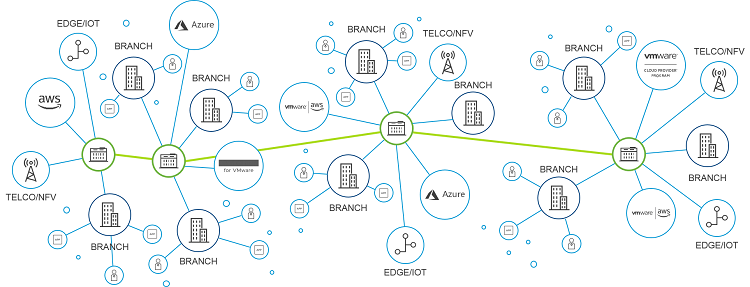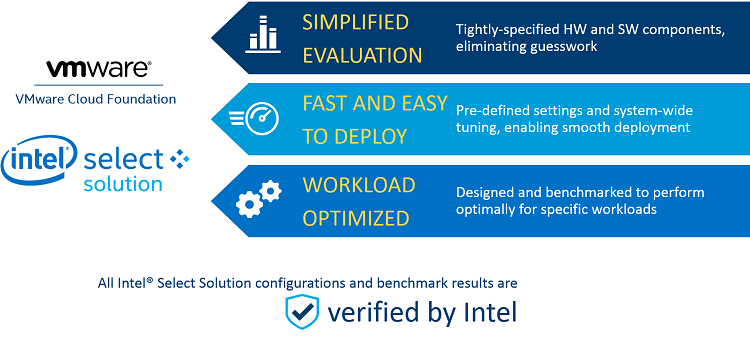VMware* and Intel team-up at industry conferences and events such as VMworld* to showcase software-defined datacenter innovations such as VMware Virtual SAN (vSAN)* running on Intel® Xeon® Scalable processors, Intel® Optane™ DC persistent memory and Non-Volatile Memory Express* (NVMe*) Solid-State Drives (SSDs) for enterprise and cloud developers and their customers.
Figure 1. Virtual Cloud Network.
VMware’s Calvin Chai joined Intel’s Bob Ghaffari to delve into the performance of software-defined technologies in their session, VMware NSX* and Getting the Most out of your Infrastructure, at a recent VMworld conference. Using metrics for latency, availability, throughput, and processing power, Calvin and Bob showed the value of a hyper-converged, software-based data center, and they described Intel and VMware technologies optimized for network workloads.
The Virtual Cloud Network illustrates that vision as a complete infrastructure in software for connecting and protecting workloads. Based on VMware NSX running on the latest Intel Xeon Scalable processors with Intel® accelerators, interconnect, network interface cards (NICs) and SSDs, the Virtual Cloud Network can deliver more operational speed and agility, simplified compliance, increased competitiveness, and increased revenue.

Figure 2. The Virtual Cloud Network is a vision of the future of networking to empower customers to connect and protect applications and data, regardless of where they sit.
Because the network is delivered in software, it brings together programmability, agility and adaptability that enables organizations to move faster, based on applications that they are deploying and managing. And security is built in, not bolted on. It is application and data centric: building consistency in the network and security policy for data and applications regardless of where they are running.
Cloud service providers and enterprise data centers use the Virtual Cloud Network for their most critical network use cases, such as:
- Security – Micro-segmentation, endpoint detection and response, encryption
- Automation – Visibility and insight, lifecycle automation, streamline operations
- Multi-cloud networking – Consistent policy, disaster recovery, workload mobility
- WAN and Branch – Branch transformation, WAN management, optimize cloud access
- Cloud-native – Container networking, container security, container visibility
Cut Through Multi-Cloud Complexity
At the same VMworld conference, VMware’s Ashvin Moro teamed up with Intel’s Melinda Safdarzadeh to present How to Cut through Multi-cloud Complexity. Their aim was to help attendees develop and deploy solutions that will provide operational simplicity, greater agility, and better performance, all at the right cost.
Digital transformation will create new possibilities. Ashvin and Melinda cited an IDC prediction that by 2020, 50% of Forbes Global* 2000 companies will see the majority of their businesses depending on digitally enhanced products, services, and experiences.
Even with tremendous growth in the public cloud, the majority of workloads reside on- premises, so there is a growing need for a hybrid cloud. That is driving robust growth in the market for hybrid cloud services, which our surveys suggest will grow at a 22.5% compound annual growth rate (CAGR) through 2021.
Many enterprises are evaluating hybrid cloud strategies as the optimal path forward, where blended use of public and private cloud infrastructures can help businesses reap the advantages of both. A hybrid approach can unleash the benefits of cloud agility and flexibility while also balancing the governance, security, and customization requirements of legacy on-premises applications.
A holistic cloud strategy begins with an evaluation of the unique characteristics and economics of public and private cloud approaches that can determine the right distribution of workloads across based on business objectives and IT policies.
That is the mission of VMware Cloud Foundation*. The fully integrated hybrid cloud platform delivers a set of software-defined services for compute, storage, networking, security, and cloud management in private or public environments.
VMware Cloud Foundation makes operating the data center simpler by deploying a standardized and validated architecture for the entire cloud stack. Cloud Foundation includes end to end security, from micro-segmentation at the networking layer down to encryption at the storage layer. And in the public cloud, VMware Cloud Foundation can be consumed as-a-service through VMware Cloud on AWS*, IBM*, Rackspace*, and others – enabling a true hybrid cloud based on a common and compatible platform that stretches from on- to off-premises.
VMware Cloud Foundation is optimized for Intel® architecture, including Intel Xeon Scalable processors, Intel® Optane™ technology, and Intel® Ethernet Converged Network Adapter (Intel® Ethernet CNA).
As Intel continues to partner with the ecosystem, we’ve found a way to deliver optimized, easy to deploy infrastructure, reducing time to deployment and value. Developed together with the leading systems and software vendors, Intel® Select Solutions reference architectures include specific hardware/firmware/software configurations.

Figure 3. As Intel continues to partner with the ecosystem, we’ve found a way to deliver optimized, easy to deploy infrastructure, reducing time to deployment and value.
The VMware Cloud Foundation joins a growing set of Intel Select Solutions, including Intel Select Solutions for vSAN*, and offers a rigorous verification process to ensure that it meets or exceeds pre-defined system level benchmarks.
For More Information
Learn more about Intel and VMware technologies for next-generation software-defined data center (SDDC), hybrid cloud, and virtualized enterprise workload solutions, and future-proof your data center solutions with AI acceleration built in.
Related Content
Second Generation Intel Xeon Processor Scalable Family Technical Overview: The new processors’ features and enhancements and how developers can take advantage of them.
Intel Optane DC Persistent Memory: A new memory class in the latest generation of Intel Xeon Scalable processors rewrites the performance equation.
Derive Value from Data Analytics and AI at Scale with Open Source Software and Intel Platform Technologies: With open source software as a catalyst, Intel innovations in communications, storage/memory and computer processing can help your enterprise move faster, store more, and process everything.